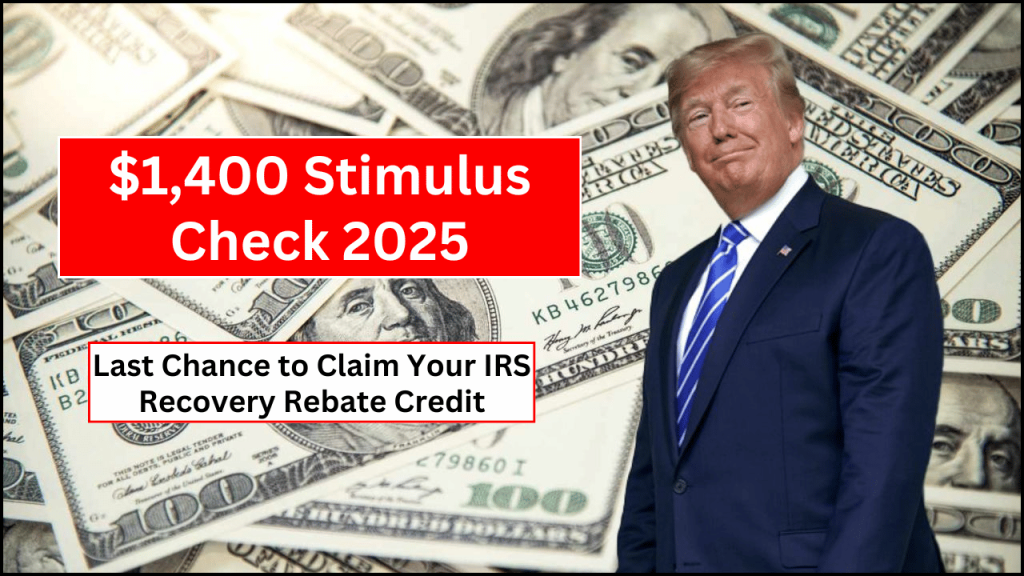
As the clock ticks down toward the April 15, 2025, deadline, the IRS is providing a much-needed lifeline to eligible taxpayers who missed out on the 2021 Recovery Rebate Credit. For many, this could mean a crucial $1,400 payment on top of their normal tax returns. With this initiative, the IRS aims to help those who didn’t claim their full Economic Impact Payments (EIPs) during the COVID-19 pandemic.
These automatic payments are set to benefit around one million taxpayers who were eligible but failed to claim the 2021 Recovery Rebate Credit. The total amount of payments expected to be issued is an estimated $2.4 billion. This initiative offers a quick and simple way for taxpayers to receive their stimulus funds without the hassle of filing amended tax returns.
Understanding the $1,400 Recovery Rebate Credit
The Recovery Rebate Credit (RRC) was initially introduced as part of the federal economic relief efforts following the COVID-19 pandemic. It was designed to provide financial assistance to individuals who missed out on their Economic Impact Payments or received less than what they were eligible for.
For 2021, individuals could claim up to $1,400 per person. This includes dependents, making it possible for families to claim a substantial amount. The best part? The RRC is fully refundable. Even if you didn’t owe any taxes, the IRS would send you a refund for the full amount of the credit you were eligible for.
With the IRS issuing automatic payments to taxpayers who missed out on claiming this credit, eligible individuals will receive their funds without having to amend their tax returns—a process that could have been time-consuming and confusing.
Who qualifies for the Automatic $1,400 Payment?
Not everyone will receive the automatic $1,400 payment. The IRS has set specific criteria to ensure that only those who were genuinely eligible and missed their claim are included in this initiative.
To qualify for the automatic payment, taxpayers must meet the following conditions:
- Filed a 2021 tax return but did not claim the Recovery Rebate Credit.
- Had a blank or incorrectly filled-out RRC field on their tax return, despite being eligible.
- Met the income eligibility requirements for the 2021 stimulus payment.
- Had a valid Social Security Number (SSN).
- Be a U.S. citizen or resident alien for tax purposes.
- Not claimed as a dependent on another person’s tax return.
Income Limits for Eligibility
Income is a key factor when determining eligibility for the Recovery Rebate Credit. The IRS uses your Adjusted Gross Income (AGI) to assess your eligibility. Here’s a quick look at the income limits for the full $1,400 payment:
| Filing Status | Full Payment Eligibility | Phase-Out Range |
|---|---|---|
| Single | Up to $75,000 | $75,000 – $80,000 |
| Head of Household | Up to $112,500 | $112,500 – $120,000 |
| Married (Joint) | Up to $150,000 | $150,000 – $160,000 |
If your income exceeds these thresholds, the credit phases out gradually. For single filers, the credit phases out completely once AGI reaches $80,000, and for married couples, the cut-off is $160,000. Taxpayers with income above these limits are ineligible for the payment.
How Will the Payments Be Issued?
The IRS will issue the automatic payments to eligible taxpayers based on the information provided in their most recent tax return. Here’s how the payments will be distributed:
- Direct Deposit: If the IRS has valid banking information on file from the taxpayer’s 2023 return, the $1,400 will be directly deposited into their account.
- Paper Check: If there is no bank account on file, the IRS will mail a physical check to the taxpayer’s last known address.
No action is required on the part of the taxpayer to receive the payment. However, if you’ve moved since filing your last return, it’s essential to update your address with the IRS to ensure you don’t miss your payment.
Important Deadlines for Filing and Claiming the Credit
For those who missed filing a 2021 tax return, there’s still time to claim the $1,400 stimulus payment. While automatic payments will be issued to eligible taxpayers by late January 2025, the final deadline for filing a 2021 tax return and claiming the Recovery Rebate Credit is April 15, 2025.
Taxpayers who have not yet filed their tax returns need to act fast to ensure they don’t miss out on the $1,400 payment. It’s important to file before this deadline to secure your funds.
IRS Scam Warnings: Protect Yourself from Fraud
As with previous stimulus payments, scams are a significant concern for taxpayers. Fraudsters often try to take advantage of vulnerable individuals by sending fraudulent emails or text messages claiming that the recipient is eligible for a $1,400 payment. These scams typically involve a link to a fake website designed to steal personal information.
To protect yourself from fraud, follow these key guidelines:
- The IRS will never send text messages or emails about stimulus payments.
- Do not click on suspicious links, as they may lead to fraudulent websites.
- Always verify payment status directly on the official IRS website at IRS.gov.
- If you suspect you’ve been targeted by a scam, report it immediately to the IRS at phishing@irs.gov.
Looking Ahead
The IRS’s $1,400 stimulus payment initiative is a significant step to ensure taxpayers who missed claiming the 2021 Recovery Rebate Credit receive the funds they were entitled to. The automatic payments aim to help around one million people who were unknowingly left out.
With the April 15 deadline fast approaching, eligible taxpayers who have not yet filed their 2021 tax return should do so as soon as possible to claim their money. As always, it’s crucial to remain vigilant against IRS-related scams. Keep your information secure and check the IRS website for the latest updates.